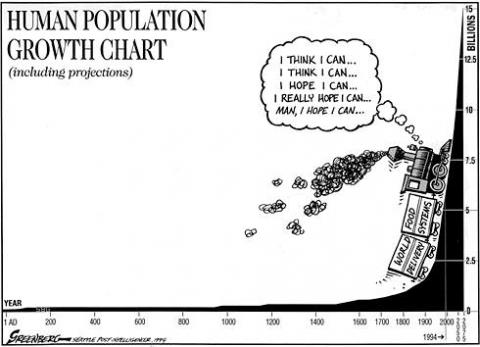One day, sometime around the middle of this century, during the lifetime of people now alive, the population of the planet will be smaller than it was the day before. Global population growth is slowing, will level off, and one remarkable day, decline.
This day will mark the dividing line – the definitive transition – between a world dominated by the concept of exponential, inexorable growth to one that has the opportunity to come to grips with true long-term global sustainability.
Ever since the dawn of humanity, the population of the planet has been growing (ok, some quibblers may point out that disruptions like the Black Plague or the Dark Ages may have briefly interrupted this inexorable growth, but they were blips in the long history of exponential population growth – see Figure 1). Our institutions, theories of resource use, and economic policies and concepts are all based on an assumption of continued population growth.

Figure 1. World human population (est.) 10,000 BC–2000 AD. Source: originally uploaded to en.wikipedia based on the “lower” estimates at census.gov.
The threats of continued population growth have long been clear: unsustainable use of resources, the challenge of meeting basic human needs for water, energy, and other basic resources, fundamental disruption from now-unavoidable global scale climate change, and the economic challenges of providing jobs, housing, education, water, energy, and transportation infrastructure for rapidly growing populations. These problems are especially severe in poorest regions of the world and the rapidly growing urban areas receiving a massive influx of young people from rural areas.
It is no surprise that some of the greatest remaining challenges with poverty are in precisely those regions where population continues to grow the fastest: parts of Africa and the Middle East. Table 1 shows those countries with population growth rates higher than 3% per year.
Table 1. Countries/Regions with population growth rates higher than 3% per year, 2011
| Country Name |
%/year |
| Rwanda |
3.0 |
| Burkina Faso |
3.0 |
| West Bank and Gaza |
3.0 |
| Mali |
3.0 |
| Tanzania |
3.0 |
| Eritrea |
3.0 |
| Yemen, Rep. |
3.1 |
| Malawi |
3.2 |
| Uganda |
3.2 |
| Liberia |
3.3 |
| Belize |
3.4 |
| Niger |
3.5 |
| South Sudan |
3.6 |
| Zambia |
4.2 |
| Bahrain |
4.8 |
| United Arab Emirates |
4.9 |
| Qatar |
6.1 |
Source: World Bank data 2013.
But the rate of population growth is slowing, as the education of women expands, health care improves, knowledge about family planning expands, and economic growth improves living conditions. The world currently adds around 78 million people a year, down from over 85 million people annually around 1990. And one day the global population as a whole will begin to shrink.
Twenty-five countries or regions (see Table 2 below) are already experiencing flat or declining populations – they actually have negative growth rates – and are moving from the difficult challenge of handling growth to the different real challenge of handling decreasing (and often aging) populations.
Table 2. Countries with zero or negative population growth rates, 2011 (percent per year)
| Country Name | %/year |
| Latvia |
-8.4 |
| Lithuania |
-8.1 |
| Bulgaria |
-2.5 |
| Portugal |
-0.8 |
| Seychelles |
-0.6 |
| Slovak Republic |
-0.6 |
| Serbia |
-0.4 |
| Puerto Rico |
-0.4 |
| Ukraine |
-0.4 |
| Croatia |
-0.3 |
| Hungary |
-0.3 |
| Romania |
-0.2 |
| Czech Republic |
-0.2 |
| Bosnia and Herzegovina |
-0.2 |
| Belarus |
-0.2 |
| Greece |
-0.1 |
| Dominica |
-0.1 |
| Greenland |
-0.1 |
| Moldova |
-0.1 |
| Malta |
-0.1 |
| Virgin Islands (U.S.) |
-0.1 |
| Cuba |
0.0 |
| Estonia |
0.0 |
| Germany |
0.0 |
| St. Vincent and the Grenadines |
0.0 |
Source: World Bank data 2013.
We don’t know what the ultimate global population peak will be. We don’t know how many additional people the planet can support, even at a low quality of life, or what the long-term stable population of the Earth should be if everyone has a decent quality of life. But the day is coming when the world’s population will peak and then begin to decline. We should be planning for it now.


Spread the word